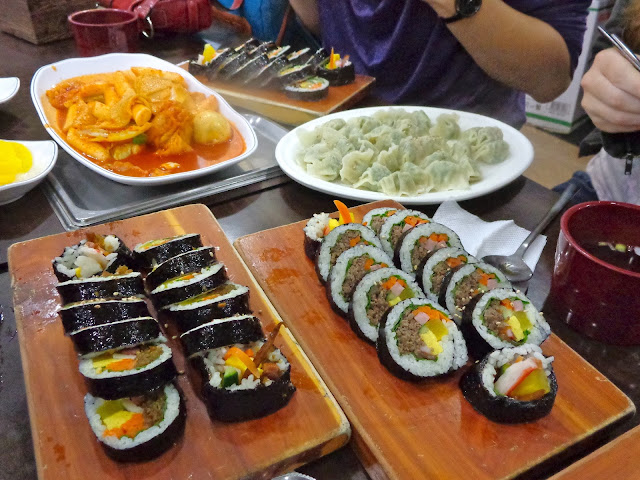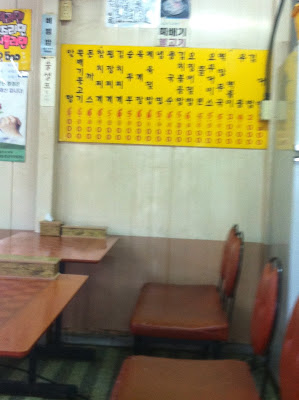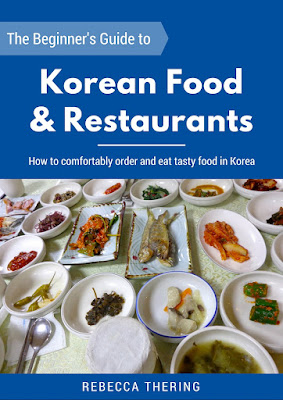Whether it’s for a short trip, extended travels or perhaps to teach English, you definitely don’t want to miss the rich world of Korean food.
Oh yummm.
As delicious as all of it is, I totally understand that some of the food can be intimidating or difficult to explore if it’s your very first time in Korea—especially with the language barrier.
I mean, consider the following:
Here’s the menu from a restaurant in the small town where I lived:
Yup, it’s that yellow sign on the wall, that’s the menu.
So I know why it could be tempting to opt for a touristy restaurant with a nice laminated menu in English and Korean (if that’s even an option!).
But don’t!
Because the food on that yellow menu? It’s incredibly delicious, cheap, and as authentic as it gets.
So that’s why I’ve put together this beginner’s guide to Korean food and restaurants filled with all of the knowledge I wish I had known when I moved to Korea in the fall of 2013. (That link goes straight to a PDF; it’s free.)
In it, you’ll learn the answers to questions such as:
- Why are there plastic “slippers” in some bathrooms and what should you do with them?
- What are those weird restaurants with the thick metal tubes coming down over each table?
- What’s the most respectful way to pay?
- How the heck am I supposed to know what/how to order when the only menu is a sign on the wall written in Korean?
… and much more. In fact, let’s take a closer look at everything covered in this 46-page guide.
Beginner’s Guide to Korean Food and Restaurants in Korea
This guide is made of the following ten chapters:
1. Introduction
My motivations for making this guide, and how I hope it’ll make you feel comfortable and confident to walk into any of these types of restaurants and enjoy a memorable meal.
2. Helpful Words to Start
The Korean words you’ll need for ordering food, asking the price, understanding Korean currency, and using the two sets of Korean numbers. (Yes, that’s right—there are two sets of numbers in Korean! But don’t worry, I’ve made it easy.)
3. Korean Street Food
Here you’ll get familiar with common tasty street foods through pictures and descriptions. These eats are sure to keep your tummy and wallet happy.
4. Korean Restaurants
This chapter contains everything you need to know to navigate Korean restaurants—from where to find the chopsticks and spoons to what you should expect in the bathrooms.
5. Traditional Korean Dishes
Organized by type, here are over 40 dishes and beverages you might see on a Korean menu.
6. Kimbap Restaurants
A type of restaurant you’ll definitely want to visit, we’ll look at 10 types of foods which are commonly served here—plus what their variations can look like.
7. Korean Barbecue
Korean barbecue is a must-do! This chapter takes you through the whole experience—from how to order the meat to what you’re supposed to do with the basket of lettuce on the table.
8. Shabu Shabu
One of my favorite meals, I had to include the interactive three-course shabu shabu experience in this guide. (And yes, like Korean barbecue, this type of meal definitely qualifies as an “experience.”)
9. Chains in Korea
A brief overview of a few common chains in Korea—in case there’s ever a day where you want to grab a really quick bite (or if you’re curious what fast food tastes like in The Land of the Morning Calm).
10. Additional Resources
Here I’ve done the searching for you and pulled together a selection of the best apps, blogs, and sites that will help you have an even easier time digging into Korean cuisine.
If you’d like to enjoy amazing and authentic food while you’re in South Korea, this e-guide will prove to be a valuable resource.
I used to sell it for $15 on Gumroad, but now offer it freely here—in the hopes that it will reach more people who can use it. If you’d like to make this a feel-good energy exchange, you’re welcome to pay what feels right for your copy here or via Venmo (@rebeccathering | last 4 of phone: -1437). Thank you!


